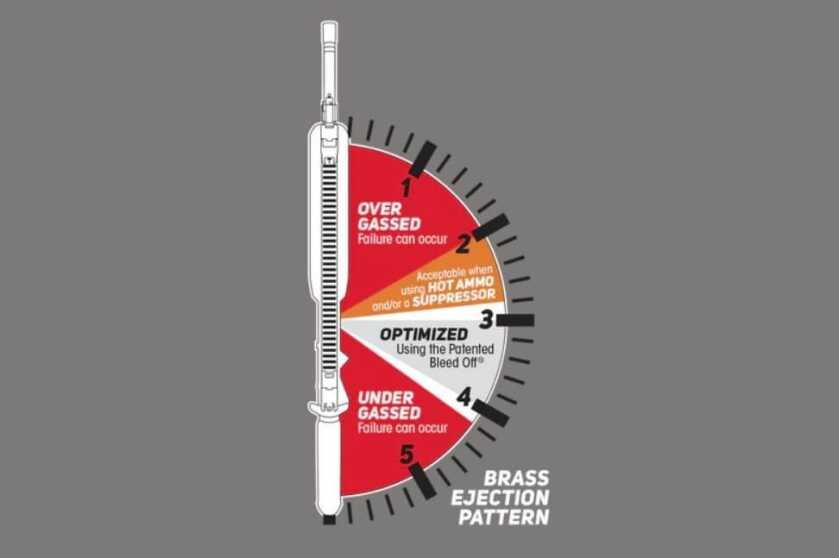

With everybody and their dog wanting a suppressor for the many benefits they provide, many wonder if an adjustable gas block is needed. One of the downsides of running a suppressor is over gassing your system which in turn can lead to cycling issues. From the factory, rifles that use a direct impingement gas system are designed for cycling reliably in their existing unsuppressed state. Originally, Eugene Stoner designed the AR platform to work unsuppressed with a specific bolt carrier group (BCG), buffer, buffer spring, then barrel and gas tube lengths, but in today’s day and age with many people “building” or assembling ARs out of random parts kits, reliable cycling can get tricky, especially when adding in suppressors.
Suppressors all operate with different internal pressures. Newer designs and flow-through systems help reduce backpressure compared to older types of suppressors, however, they still add to gas blowback and make an AR cycle more violently than it would unsuppressed. In a world full of uncertainties, finding a way to pull everything together and tune it into one well-operating machine is imperative.
Fixed gas blocks often over-gas a firearm. There is no adjustment for these, and whenever the bullet is propelled past the port drilled in the barrel, hot gasses expand through the hole, push through the gas tube, and straight into the BCG. While an over-gassed AR will cycle better in adverse conditions than an under-gassed one, this creates excessive wear and tear. The excess gasses being blown back can create violent cycling, increased recoil, gassier operation, and extra wear and tear on the internal components of the operating system.
The addition of an adjustable gas block is probably the most cost-effective way to tune an AR. Instead of trying out multiple buffer weights to fit a specific weighted BCG, an adjustable gas block will allow you to choose how much gas can enter the gas tube. This allows for finely tuning an AR to get a balance of enough gas to cycle reliably, yet not too much to create excessive blowback. Too much blowback creates a gassier experience when shooting suppressed. Gassier means lots of extra crap and gas blowing back into your action, eyes, nose, and mouth. In the image below, Superlative Arms made a diagram to show where an ideal ejection pattern for brass should be.

Tuning these adjustable gas blocks is easy to do, and many companies offer different solutions that all accomplish the same thing. These systems help tune how much gas is allowed to enter the gas tube to propel the BCG backward to cycle the firearm.
Suppressors Delivered to Your Door
One call, does it all. Select your suppressor, create your trust, fit your gun, deliver to your doorstep. Silencer Central – Simple, Smart, Easy! Call 888-781-8778 or visit https://www.silencercentral.com/about-us/
So in the end, is an adjustable gas block absolutely required for an AR when adding a suppressor into the midst? Most likely not. Should they be added to a suppressed AR? I would say yes. The majority of ARs will still cycle and work just fine without an adjustable gas block while just being over-gassed. However, an over-gassed system can still have reliability issues. Excessive gas blowback increases the bolt speed and can cause the BCG to not lock back on an empty magazine. It could also decrease velocity due to the bolt unlocking quicker all while being dirtier, and gassier, creating excessive wear and tear, and increasing recoil. Adjustable gas blocks are a great tool, and allow one to easily fine-tune an AR. In the age of suppressors, I would highly recommend them.
Adjusting a Gas Block
Always follow the manufactures instructions for adjusting their specific gas block. However, if you have a generic gas block here is a simple way to adjust it.
- After installing turn the gas block way down so that it shuts off the gas.
- Count the clicks but you can usually safely start between 5-10.
- Place one (1) round in a magazine and fire the round. Most likely the bolt will not stay open and the empty case may not have ejected. This means that the gas block isn’t allowing enough gas to enter your system to operate the bolt.
- Open the gas block another click and load and fire another round. Continue to do this until the bolt locks open.
- Record how many clicks it took to get your bolt to lock open. This setting is the absolute minimum gas requirement for your gun to function.
- Open the gas block one click further than what is required for it to lock open. The one extra click is so the gun will still run in colder or dirtier conditions.
Gas Blocks We’ve Used and Recommend at GunsAmerica

Superlative Arms Adjustable Gas Blocks
Odin Works Adjustable Gas Blocks
Seekins Precision Adjustable Gas Blocks
***Buy and Sell on GunsAmerica! All Local Sales are FREE!***



IF YOU ARE LIKE ME, YOU HAVE A SURPRESSOR THATS MOUNTED CLOSE TO YOUR HAND GUARD OR INSIDE YOUR HANDGUARD. AND WITH A SHORT BARREL. I FRUTHER HAVE SWITCH BARRELS OF .300 B/P AND 5.56MM, CAUSING MORE PROBLEMS. IT IS TO INCONVIENT TO ADJUST THE GAS BLOCK INSIDE THE HANDGUARD, WHAT I DID WAS TO GET A STRIKE INDUSTRIES ADJ, GAS BLOCK. IT HAS SOLVED MOST OF MY PROBLEMS. THERE IS GAS LEAKAGE WITH MY AR BUT I GUESS I HAVE TO MAN UP, CANT HAVE EVERYTHING.